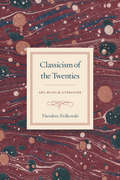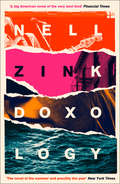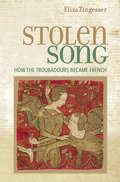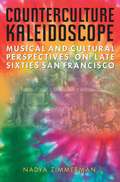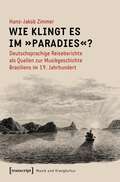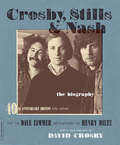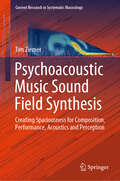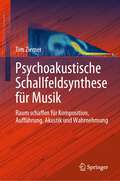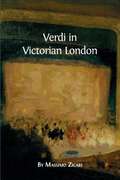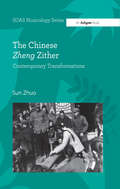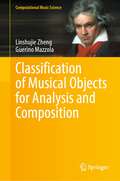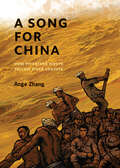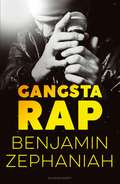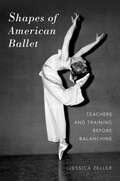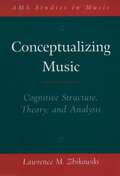- Table View
- List View
Classicism of the Twenties: Art, Music, and Literature
by Theodore ZiolkowskiThe triumph of avant-gardes in the 1920s tends to dominate our discussions of the music, art, and literature of the period. But the broader current of modernism encompassed many movements, and one of the most distinct and influential was a turn to classicism. In Classicism of the Twenties, Theodore Ziolkowski offers a compelling account of that movement. Giving equal attention to music, art, and literature, and focusing in particular on the works of Stravinsky, Picasso, and T. S. Eliot, he shows how the turn to classicism manifested itself. In reaction both to the excesses of neoromanticism and early modernism and to the horrors of World War I—and with respectful detachment—artists, writers, and composers adapted themes and forms from the past and tried to imbue their own works with the values of simplicity and order that epitomized earlier classicisms. By identifying elements common to all three arts, and carefully situating classicism within the broader sweep of modernist movements, Ziolkowski presents a refreshingly original view of the cultural life of the 1920s.
Classicism of the Twenties: Art, Music, and Literature
by Theodore ZiolkowskiThe triumph of avant-gardes in the 1920s tends to dominate our discussions of the music, art, and literature of the period. But the broader current of modernism encompassed many movements, and one of the most distinct and influential was a turn to classicism. In Classicism of the Twenties, Theodore Ziolkowski offers a compelling account of that movement. Giving equal attention to music, art, and literature, and focusing in particular on the works of Stravinsky, Picasso, and T. S. Eliot, he shows how the turn to classicism manifested itself. In reaction both to the excesses of neoromanticism and early modernism and to the horrors of World War I—and with respectful detachment—artists, writers, and composers adapted themes and forms from the past and tried to imbue their own works with the values of simplicity and order that epitomized earlier classicisms. By identifying elements common to all three arts, and carefully situating classicism within the broader sweep of modernist movements, Ziolkowski presents a refreshingly original view of the cultural life of the 1920s.
Classicism of the Twenties: Art, Music, and Literature
by Theodore ZiolkowskiThe triumph of avant-gardes in the 1920s tends to dominate our discussions of the music, art, and literature of the period. But the broader current of modernism encompassed many movements, and one of the most distinct and influential was a turn to classicism. In Classicism of the Twenties, Theodore Ziolkowski offers a compelling account of that movement. Giving equal attention to music, art, and literature, and focusing in particular on the works of Stravinsky, Picasso, and T. S. Eliot, he shows how the turn to classicism manifested itself. In reaction both to the excesses of neoromanticism and early modernism and to the horrors of World War I—and with respectful detachment—artists, writers, and composers adapted themes and forms from the past and tried to imbue their own works with the values of simplicity and order that epitomized earlier classicisms. By identifying elements common to all three arts, and carefully situating classicism within the broader sweep of modernist movements, Ziolkowski presents a refreshingly original view of the cultural life of the 1920s.
Doxology: A Novel
by Nell ZinkTwo generations of an American family come of age – one before 9/11, one after – in this moving and original novel from the “intellectually restless, uniquely funny” (New York Times Book Review) mind of Nell Zink
Stolen Song: How the Troubadours Became French
by Eliza ZingesserStolen Song documents the act of cultural appropriation that created a founding moment for French literary history: the rescripting and domestication of troubadour song, a prestige corpus in the European sphere, as French. This book also documents the simultaneous creation of an alternative point of origin for French literary history—a body of faux-archaic Occitanizing songs.Most scholars would find the claim that troubadour poetry is the origin of French literature uncomplicated and uncontroversial. However, Stolen Song shows that the "Frenchness" of this tradition was invented, constructed, and confected by francophone medieval poets and compilers keen to devise their own literary history.Stolen Song makes a major contribution to medieval studies both by exposing this act of cultural appropriation as the origin of the French canon and by elaborating a new approach to questions of political and cultural identity. Eliza Zingesser shows that these questions, usually addressed on the level of narrative and theme, can also be fruitfully approached through formal, linguistic, and manuscript-oriented tools.
Counterculture Kaleidoscope: Musical and Cultural Perspectives on Late Sixties San Francisco
by Nadya ZimmermanForty years after the fact, 1960s counterculture---personified by hippies, protest, and the Summer of Love---basks in a nostalgic glow in the popular imagination as a turning point in modern American history and the end of the age of innocence. Yet, while the era has come to be synonymous with rebellion and opposition, its truth is much more complex. In a bold reconsideration of the late sixties San Francisco counterculture movement, Counterculture Kaleidoscope takes a close look at the cultural and musical practices of that era. Addressing the conventional wisdom that the movement was grounded in rebellion and opposition, the book exposes two myths: first, that the counterculture was an organized social and political movement of progressives with a shared agenda who opposed the mainstream (dubbed "hippies"); and second, that the counterculture was an innocent entity hijacked by commercialism and transformed over time into a vehicle of so-called "hip consumerism." Seeking an alternative to the now common narrative, Nadya Zimmerman examines primary source material including music, artwork, popular literature, personal narratives, and firsthand historical accounts. She reveals that the San Francisco counterculture wasn't interested in commitments to causes and made no association with divisive issues---that it embraced everything in general and nothing in particular. "Astute and accessible, Counterculture Kaleidoscope provides thought-provoking insights into the historical, cultural and social context of the San Francisco counter-culture and its music scene, including discussions of Vietnam and student protest, the Haight-Ashbury Diggers, the Grateful Dead, Led Zeppelin, Altamont, and Charlie Manson. A must for students and scholars of socio-musical activity and for all of us to whom music matters." ---Sheila Whiteley, author of The Space Between the Notes: Rock and the Counter-Culture and Too Much Too Young: Popular Music, Age and Gender "The hippie counterculture has never garnered the scholarly attention accorded the new left and the black freedom struggle. Overviews of the period ritualistically mention it as part and parcel of that apparently incandescent era---the Sixties---but rarely capture its distinctiveness. Counterculture Kaleidoscope is a timely and provocative intervention in Sixties scholarship that significantly deepens our understanding of this important but understudied phenomenon." —Alice Echols, Associate Professor, University of Southern California, and author of Scars of Sweet Paradise: The Life and Times of Janis Joplin
Wie klingt es im »Paradies«?: Deutschsprachige Reiseberichte als Quellen zur Musikgeschichte Brasiliens im 19. Jahrhundert (Musik und Klangkultur #38)
by Hans-Jakob ZimmerReiseberichten eilt in der Musikforschung ein ambivalenter Ruf voraus: Mitunter kategorisch abgelehnt als ernst zu nehmende Quellen, bergen sie gleichwohl häufig einzigartige Informationen zur musikalischen Frühgeschichte von Ethnien und Ländern. Darüber hinaus erweisen sie sich als wertvolle mentalitätsgeschichtliche Dokumente ihrer Autor_innen. Hans-Jakob Zimmer unternimmt die bislang umfangreichste Auswertung deutschsprachiger Reiseberichte im Hinblick auf das Musikleben des Landes Brasilien, welches nach der Umsiedlung des portugiesischen Königshofs nach Rio de Janeiro im Jahr 1808 zu einem Sehnsuchtsort für Naturforscher, Reisende und Auswanderer avancierte.
Crosby, Stills & Nash: The Biography
by Dave ZimmerCrosby, Stills & Nash created some of the most indelible songs and beautiful harmonies of the late 1960s and early 1970s: "Suite: Judy Blue Eyes," "Woodstock," "Teach Your Children."This copiously illustrated account of the trio's personal and musical history tells the story behind the songs. Longtime CSN chronicler Dave Zimmer, with the full cooperation of the band, traces all of the performers from their musical roots to their first song together in L.A.'s storied Laurel Canyon; from their addition of Neil Young to Woodstock; and through their stormy years of creative conflicts, reunions, and reconciliations.This edition celebrates the trio's 40th anniversary and includes over 300 photos.
Crosby, Stills & Nash: The Biography
by Dave ZimmerCrosby, Stills & Nash created some of the most indelible songs and beautiful harmonies of the late 1960s and early 1970s: "Suite: Judy Blue Eyes," "Woodstock," "Teach Your Children."This copiously illustrated account of the trio's personal and musical history tells the story behind the songs. Longtime CSN chronicler Dave Zimmer, with the full cooperation of the band, traces all of the performers from their musical roots to their first song together in L.A.'s storied Laurel Canyon; from their addition of Neil Young to Woodstock; and through their stormy years of creative conflicts, reunions, and reconciliations.This edition celebrates the trio's 40th anniversary and includes over 300 photos.
Psychoacoustic Music Sound Field Synthesis: Creating Spaciousness for Composition, Performance, Acoustics and Perception (Current Research in Systematic Musicology #7)
by Tim ZiemerThis book provides a broad overview of spaciousness in music theory, from mixing and performance practice, to room acoustics, psychoacoustics and audio engineering, and presents the derivation, implementation and experimental validation of a novel type of spatial audio system. Discussing the physics of musical instruments and the nature of auditory perception, the book enables readers to precisely localize synthesized musical instruments while experiencing their timbral variance and spatial breadth.Offering interdisciplinary insights for novice music enthusiasts and experts in the field of spatial audio, this book is suitable for anyone interested in the study of music and musicology and the application of spatial audio mixing, or those seeking an overview of the state of the art in applied psychoacoustics for spatial audio.
Psychoakustische Schallfeldsynthese für Musik: Raum schaffen für Komposition, Aufführung, Akustik und Wahrnehmung
by Tim ZiemerDieses Buch bietet einen umfassenden Überblick über die Räumlichkeit in der Musiktheorie, von der Abmischung und Aufführungspraxis bis hin zur Raumakustik, Psychoakustik und Tontechnik, und stellt die Ableitung, Implementierung und experimentelle Validierung eines neuartigen räumlichen Audiosystems vor. Durch die Erörterung der Physik von Musikinstrumenten und der Natur der auditiven Wahrnehmung ermöglicht das Buch den Lesern, synthetische Musikinstrumente präzise zu lokalisieren und gleichzeitig ihre klangliche Varianz und räumliche Weite zu erleben. Dieses Buch bietet interdisziplinäre Einblicke für Musikneulinge und Experten auf dem Gebiet der räumlichen Audiotechnik. Es eignet sich für alle, die sich für das Studium von Musik und Musikwissenschaft und die Anwendung von räumlichen Audiomischungen interessieren oder einen Überblick über den Stand der Technik in der angewandten Psychoakustik für räumliches Audio suchen.
Verdi in Victorian London
by Massimo ZicariNow a byword for beauty, Verdi’s operas were far from universally acclaimed when they reached London in the second half of the nineteenth century. Why did some critics react so harshly? Who were they and what biases and prejudices animated them? When did their antagonistic attitude change? And why did opera managers continue to produce Verdi’s operas, in spite of their alleged worthlessness? Massimo Zicari’s Verdi in Victorian London reconstructs the reception of Verdi’s operas in London from 1844, when a first critical account was published in the pages of The Athenaeum, to 1901, when Verdi’s death received extensive tribute in The Musical Times. In the 1840s, certain London journalists were positively hostile towards the most talked-about representative of Italian opera, only to change their tune in the years to come. The supercilious critic of The Athenaeum, Henry Fothergill Chorley, declared that Verdi’s melodies were worn, hackneyed and meaningless, his harmonies and progressions crude, his orchestration noisy. The scribes of The Times, The Musical World, The Illustrated London News, and The Musical Times all contributed to the critical hubbub. Yet by the 1850s, Victorian critics, however grudging, could neither deny nor ignore the popularity of Verdi’s operas. Over the final three decades of the nineteenth century, moreover, London’s musical milieu underwent changes of great magnitude, shifting the manner in which Verdi was conceptualized and making room for the powerful influence of Wagner. Nostalgic commentators began to lament the sad state of the Land of Song, referring to the now departed "palmy days of Italian opera." Zicari charts this entire cultural constellation. Verdi in Victorian London is required reading for both academics and opera aficionados. Music specialists will value a historical reconstruction that stems from a large body of first-hand source material, while Verdi lovers and Italian opera addicts will enjoy vivid analysis free from technical jargon. For students, scholars and plain readers alike, this book is an illuminating addition to the study of music reception.
Verdi in Victorian London
by Massimo ZicariNow a byword for beauty, Verdi’s operas were far from universally acclaimed when they reached London in the second half of the nineteenth century. Why did some critics react so harshly? Who were they and what biases and prejudices animated them? When did their antagonistic attitude change? And why did opera managers continue to produce Verdi’s operas, in spite of their alleged worthlessness? Massimo Zicari’s Verdi in Victorian London reconstructs the reception of Verdi’s operas in London from 1844, when a first critical account was published in the pages of The Athenaeum, to 1901, when Verdi’s death received extensive tribute in The Musical Times. In the 1840s, certain London journalists were positively hostile towards the most talked-about representative of Italian opera, only to change their tune in the years to come. The supercilious critic of The Athenaeum, Henry Fothergill Chorley, declared that Verdi’s melodies were worn, hackneyed and meaningless, his harmonies and progressions crude, his orchestration noisy. The scribes of The Times, The Musical World, The Illustrated London News, and The Musical Times all contributed to the critical hubbub. Yet by the 1850s, Victorian critics, however grudging, could neither deny nor ignore the popularity of Verdi’s operas. Over the final three decades of the nineteenth century, moreover, London’s musical milieu underwent changes of great magnitude, shifting the manner in which Verdi was conceptualized and making room for the powerful influence of Wagner. Nostalgic commentators began to lament the sad state of the Land of Song, referring to the now departed "palmy days of Italian opera." Zicari charts this entire cultural constellation. Verdi in Victorian London is required reading for both academics and opera aficionados. Music specialists will value a historical reconstruction that stems from a large body of first-hand source material, while Verdi lovers and Italian opera addicts will enjoy vivid analysis free from technical jargon. For students, scholars and plain readers alike, this book is an illuminating addition to the study of music reception.
Verdi in Victorian London (PDF)
by Massimo ZicariNow a byword for beauty, Verdi's operas were far from universally acclaimed when they reached London in the second half of the nineteenth century. Why did some critics react so harshly? Who were they and what biases and prejudices animated them? When did their antagonistic attitude change? And why did opera managers continue to produce Verdi's operas, in spite of their alleged worthlessness? Massimo Zicari's Verdi in Victorian London reconstructs the reception of Verdi's operas in London from 1844, when a first critical account was published in the pages of The Athenaeum, to 1901, when Verdi's death received extensive tribute in The Musical Times. In the 1840s, certain London journalists were positively hostile towards the most talked-about representative of Italian opera, only to change their tune in the years to come. The supercilious critic of The Athenaeum, Henry Fothergill Chorley, declared that Verdi's melodies were worn, hackneyed and meaningless, his harmonies and progressions crude, his orchestration noisy. The scribes of The Times, The Musical World, The Illustrated London News, and The Musical Times all contributed to the critical hubbub. Yet by the 1850s, Victorian critics, however grudging, could neither deny nor ignore the popularity of Verdi's operas. Over the final three decades of the nineteenth century, moreover, London's musical milieu underwent changes of great magnitude, shifting the manner in which Verdi was conceptualized and making room for the powerful influence of Wagner. Nostalgic commentators began to lament the sad state of the Land of Song, referring to the now departed "palmy days of Italian opera." Zicari charts this entire cultural constellation. Verdi in Victorian London is required reading for both academics and opera aficionados. Music specialists will value a historical reconstruction that stems from a large body of first-hand source material, while Verdi lovers and Italian opera addicts will enjoy vivid analysis free from technical jargon. For students, scholars and plain readers alike, this book is an illuminating addition to the study of music reception.
The Voice of the Century: The Culture of Italian Bel Canto in Luisa Tetrazzini’s Recorded Interpretations
by Massimo ZicariThe fields of performance studies, empirical musicology, and the musicology of recordings have seen a tremendous development in recent years, shedding new light on the recent history of our performing tradition and conveying essential information to music practitioners, critics and audiences. This innovative work considers the notion of bel canto and the manner in which this vibrant tradition lives in the records of Luisa Tetrazzini (1871-1940), one of the most celebrated sopranos ever. Tetrazzini, whose discographic career includes about 120 recordings, belongs to that generation of inspirational performers who heralded the dawn of a new era of music appreciation, alongside such iconic figures as Enrico Caruso, Adelina Patti and Nellie Melba. Drawing on a vast body of scholarship and a number of contemporary reviews, Massimo Zicari establishes Tetrazzini’s role in the Italian operatic tradition and its much disputed set of performing conventions. His transcriptions of her recorded interpretations from Rossini, Donizetti, Bellini and Verdi will prove invaluable to singers and conductors interested in a tradition that goes back to legendary figures such as Jenny Lind and Maria Malibran. The author also discusses her voice quality and technique, tempo flexibility, her use of vibrato and portamento—features of musical performance that question several widely-held, normative views about aesthetics and interpretative tradition. The volume includes eighty-eight musical examples and its closing section consists of the vocal scores of thirteen operatic arias. The musical material (both examples and transcriptions) is entirely original. This unique approach seeks to combine an academic perspective with the making of the music, in the hope that the plea for originality may be enhanced by models from the past.
The Chinese Zheng Zither: Contemporary Transformations (SOAS Studies in Music Series)
by Sun ZhuoThe zheng zither is one of the most popular instruments in contemporary China. It is commonly regarded as a solo instrument with a continuous tradition dating back to ancient times. But in fact, much of its contemporary solo repertory is derived from several different regional folk ensemble repertories of the mid-twentieth century. Since the setting up of China’s modern conservatories, the zheng has been transformed within these new contexts of professional music-making. Over the course of the twentieth century, these regional folk repertories were brought into the performance traditions of modern regional zheng schools. From this basis, a large new zheng repertory was created by conservatory musicians, combining aspects of Western classical music with folk music materials. With the ’opening up’ of China’s economy since the 1980s, the zheng has been brought into the wider stage of international music-making which includes contemporary art music compositions by overseas based Chinese composers and commercial world music works by Western composers. Through a series of case studies, this book explores how the transformation of the Chinese zheng has constantly responded to its changing social context, critiquing the long-standing arguments concerning ’authenticity’ in the development of tradition. This work arises out of, and reflects on, the research methodologies known as performance as research. As an insider to the tradition, brought up within China’s zheng society, a trained and practising zheng performer, this study is largely drawn from the author's own experiences of practising and performing the music in question; her study also draws on fieldwork, as well as primary and secondary written sources in Chinese and English. This book is accompanied by a DVD which contains audio visual materials relating to the author's fieldwork and zheng performances by different zheng musicians.
The Chinese Zheng Zither: Contemporary Transformations (SOAS Studies in Music Series)
by Sun ZhuoThe zheng zither is one of the most popular instruments in contemporary China. It is commonly regarded as a solo instrument with a continuous tradition dating back to ancient times. But in fact, much of its contemporary solo repertory is derived from several different regional folk ensemble repertories of the mid-twentieth century. Since the setting up of China’s modern conservatories, the zheng has been transformed within these new contexts of professional music-making. Over the course of the twentieth century, these regional folk repertories were brought into the performance traditions of modern regional zheng schools. From this basis, a large new zheng repertory was created by conservatory musicians, combining aspects of Western classical music with folk music materials. With the ’opening up’ of China’s economy since the 1980s, the zheng has been brought into the wider stage of international music-making which includes contemporary art music compositions by overseas based Chinese composers and commercial world music works by Western composers. Through a series of case studies, this book explores how the transformation of the Chinese zheng has constantly responded to its changing social context, critiquing the long-standing arguments concerning ’authenticity’ in the development of tradition. This work arises out of, and reflects on, the research methodologies known as performance as research. As an insider to the tradition, brought up within China’s zheng society, a trained and practising zheng performer, this study is largely drawn from the author's own experiences of practising and performing the music in question; her study also draws on fieldwork, as well as primary and secondary written sources in Chinese and English. This book is accompanied by a DVD which contains audio visual materials relating to the author's fieldwork and zheng performances by different zheng musicians.
Classification of Musical Objects for Analysis and Composition (Computational Music Science)
by Linshujie Zheng Guerino MazzolaThis book presents and discusses the fundamental topic of classification of musical objects, such as chords, motifs, and gestures. Their classification deals with the exhibition of isomorphism classes. Our structure types include local and global constructions, the latter being similar to global structures in geometry, such as differentiable manifolds. The discussion extends to the role, which classification plays for the creative construction of musical compositions. Our examples include references to classical compositions, such as Beethoven’s sonatas, and some of the author’s own compositions of classical and jazz styles. We also discuss software that enables the application of classification to musical creativity. The volume is addressed to an audience that would apply classification to programming and creative musical construction.
A Song for China: How My Father Wrote Yellow River Cantata
by Ange ZhangPublished in celebration of the famous Yellow River Cantata’s 80th anniversary, this is the riveting history of how a young Chinese author and passionate militant fought using art to create a socially just China during the period of the struggle against the Japanese and during World War II.This is the fascinating story of how a young Chinese author, Guang Weiran, a passionate militant from the age of twelve, fought, using art, theater, poetry and song, especially the famous Yellow River Cantata — the anthem of Chinese national spirit — to create a socially just China. Set during the period of the struggle against the Japanese and the war against the Kuomintang in the 1920s and ’30s, this book, written and illustrated by Guang Weiran’s award-winning artist son, Ange Zhang, illuminates a key period in China’s history. The passion and commitment of the artists who were born under the repressive weight of the Japanese occupation, the remnants of the decaying imperial order and the times of colonial humiliation are inspiring.Zhang’s words and wood-block style of art tell us the story of his father’s extraordinary youth and very early rise to prominence due to his great talent with words. We see and hear the intensity of what it meant to be alive at such a significant moment in the history of China, a country that understands itself as the heir to one of the greatest civilizations the world has ever known. The humiliations and social injustice the Chinese people had endured in the colonial period were no longer bearable. And yet there were major factional differences between those who wanted to create a modern China. Ange’s words and art paint the picture for us through his father’s story, accompanied by sidebars that explain the historical context.The book ends in a burst of glorious color and song, with the words of Yellow River Cantata in Mandarin, as well as newly translated into English. This great song turns eighty years old in 2019, and will be sung and performed by huge orchestras and choirs around the world, as the Chinese diaspora has embraced the cantata as its own.Key Text Features historical context sidebars illustrations lyricsCorrelates to the Common Core State Standards in English Language Arts:CCSS.ELA-LITERACY.RI.6.2 Determine a central idea of a text and how it is conveyed through particular details; provide a summary of the text distinct from personal opinions or judgments.CCSS.ELA-LITERACY.RI.6.6 Determine an author's point of view or purpose in a text and explain how it is conveyed in the text.CCSS.ELA-LITERACY.RI.6.7 Integrate information presented in different media or formats (e.g., visually, quantitatively) as well as in words to develop a coherent understanding of a topic or issue.
Gangsta Rap (New Windmills Ks3 Ser.)
by Mr Benjamin ZephaniahJust what do you do with talent from the wrong side of town? Benjamin Zephaniah draws on his own experiences with school and the music business to create a novel that speaks with passion and immediacy about the rap scene.Ray has trouble at home, and he has trouble at school – until he's permanently excluded and ends up sleeping on the floor of a record shop. What happens to a boy like Ray? If he's lucky, maybe he gets a chance to shine.The story of three boys who aren't easy. They don't fit in. They seem to attract trouble. But they know what they want, and they've got the talent to back it up ...Brilliantly written and with a real ear for dialogue, fans of Angie Thomas and Malorie Blackman will love Benjamin Zephaniah's novels for young adult readers: Refugee BoyFaceGangsta RapTeacher's Dead
Shapes of American Ballet: Teachers and Training before Balanchine
by Jessica ZellerIn Shapes of American Ballet: Teachers and Training before Balanchine, Jessica Zeller introduces the first few decades of the twentieth century as an often overlooked, yet critical period for ballet's growth in America. While George Balanchine is often considered the sole creator of American ballet, numerous European and Russian émigrés had been working for decades to build a national ballet with an American identity. These pedagogues and others like them played critical yet largely unacknowledged roles in American ballet's development. Despite their prestigious ballet pedigrees, the dance field's exhaustive focus on Balanchine has led to the neglect of their work during the first few decades of the century, and in this light, this book offers a new perspective on American ballet during the period immediately prior to Balanchine's arrival. Zeller uses hundreds of rare archival documents to illuminate the pedagogies of several significant European and Russian teachers who worked in New York City. Bringing these contributions into the broader history of American ballet recasts American ballet's identity as diverse-comprised of numerous Euro-Russian and American elements, as opposed to the work of one individual. This new account of early twentieth century American ballet is situated against a bustling New York City backdrop, where mass immigration through Ellis Island brought the ballet from European and Russian opera houses into contact with a variety of American forms and sensibilities. Ballet from celebrated Euro-Russian lineages was performed in vaudeville and blended with American popular dance styles, and it developed new characteristics as it responded to the American economy. Shapes of American Ballet delves into ballet's struggle to define itself during this rich early twentieth century period, and it sheds new light on ballet's development of an American identity before Balanchine.
SHAPES OF AMERICAN BALLET C: Teachers and Training before Balanchine
by Jessica ZellerIn Shapes of American Ballet: Teachers and Training before Balanchine, Jessica Zeller introduces the first few decades of the twentieth century as an often overlooked, yet critical period for ballet's growth in America. While George Balanchine is often considered the sole creator of American ballet, numerous European and Russian émigrés had been working for decades to build a national ballet with an American identity. These pedagogues and others like them played critical yet largely unacknowledged roles in American ballet's development. Despite their prestigious ballet pedigrees, the dance field's exhaustive focus on Balanchine has led to the neglect of their work during the first few decades of the century, and in this light, this book offers a new perspective on American ballet during the period immediately prior to Balanchine's arrival. Zeller uses hundreds of rare archival documents to illuminate the pedagogies of several significant European and Russian teachers who worked in New York City. Bringing these contributions into the broader history of American ballet recasts American ballet's identity as diverse-comprised of numerous Euro-Russian and American elements, as opposed to the work of one individual. This new account of early twentieth century American ballet is situated against a bustling New York City backdrop, where mass immigration through Ellis Island brought the ballet from European and Russian opera houses into contact with a variety of American forms and sensibilities. Ballet from celebrated Euro-Russian lineages was performed in vaudeville and blended with American popular dance styles, and it developed new characteristics as it responded to the American economy. Shapes of American Ballet delves into ballet's struggle to define itself during this rich early twentieth century period, and it sheds new light on ballet's development of an American identity before Balanchine.
Die Opera buffa in Europa: Verbreitungs- und Transformationsprozesse einer neuen Gattung (1740-1765) (Vernetzen - bewegen - verorten. Kulturwissenschaftliche Perspektiven #3)
by Andrea Zedler Lena van Hoven Kordula KnausDie Etablierung der Opera buffa veränderte die Opernlandschaft des 18. Jahrhunderts maßgeblich. Sie stellte einen inhaltlichen Kontrapunkt zur höfisch geprägten Opera seria dar und löste diese zunehmend in den Spielplänen ab. Wie aber ging die europaweite Verbreitung der komischen italienischen Oper vor sich? Wo konnte sie sich rascher als anderswo etablieren und wer waren die zentralen Akteurinnen und Akteure? Welche Rolle spielten mobile Operntruppen und wie verhielten sich die Höfe zu dem neuen Genre? Erstmals nehmen die Autorinnen in einer systematischen Analyse der Opera buffa in Europa Migration, Mobilität, Netzwerke und Transformationsprozesse zwischen 1740 und 1765 in den Blick. Mit einem Gastbeitrag von Tom Brökel und Heike Brökel.
Conceptualizing Music: Cognitive Structure, Theory, and Analysis (AMS Studies in Music)
by Lawrence M. ZbikowskiThis book shows how recent work in cognitive science, especially that developed by cognitive linguists and cognitive psychologists, can be used to explain how we understand music. The book focuses on three cognitive processes--categorization, cross-domain mapping, and the use of conceptual models--and explores the part these play in theories of musical organization. The first part of the book provides a detailed overview of the relevant work in cognitive science, framed around specific musical examples. The second part brings this perspective to bear on a number of issues with which music scholarship has often been occupied, including the emergence of musical syntax and its relationship to musical semiosis, the problem of musical ontology, the relationship between words and music in songs, and conceptions of musical form and musical hierarchy. The book will be of interest to music theorists, musicologists, and ethnomusicologists, as well as those with a professional or avocational interest in the application of work in cognitive science to humanistic principles.
Conceptualizing Music: Cognitive Structure, Theory, and Analysis (AMS Studies in Music)
by Lawrence M. ZbikowskiThis book shows how recent work in cognitive science, especially that developed by cognitive linguists and cognitive psychologists, can be used to explain how we understand music. The book focuses on three cognitive processes--categorization, cross-domain mapping, and the use of conceptual models--and explores the part these play in theories of musical organization. The first part of the book provides a detailed overview of the relevant work in cognitive science, framed around specific musical examples. The second part brings this perspective to bear on a number of issues with which music scholarship has often been occupied, including the emergence of musical syntax and its relationship to musical semiosis, the problem of musical ontology, the relationship between words and music in songs, and conceptions of musical form and musical hierarchy. The book will be of interest to music theorists, musicologists, and ethnomusicologists, as well as those with a professional or avocational interest in the application of work in cognitive science to humanistic principles.
